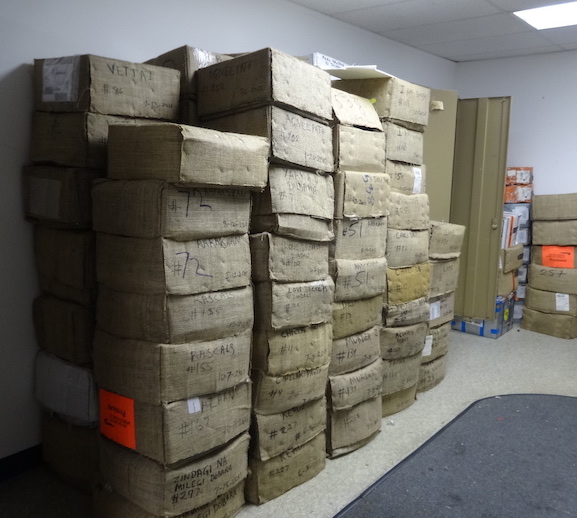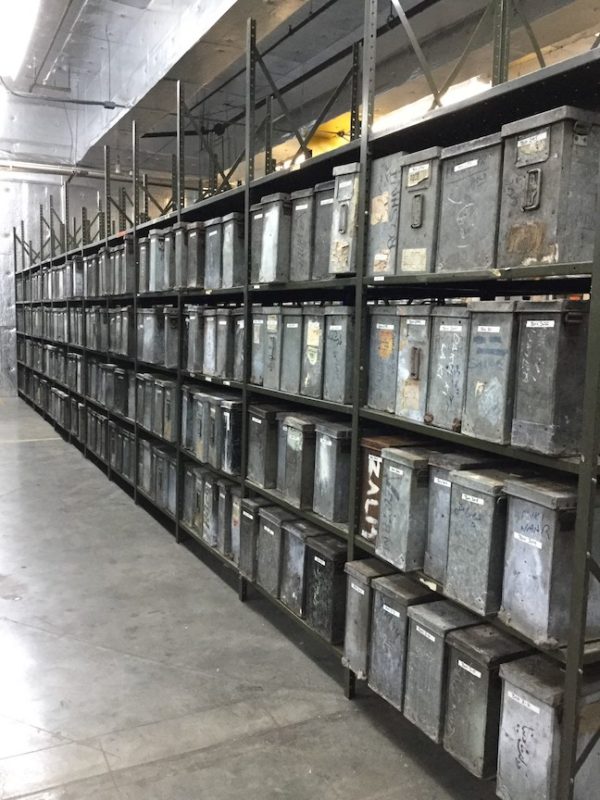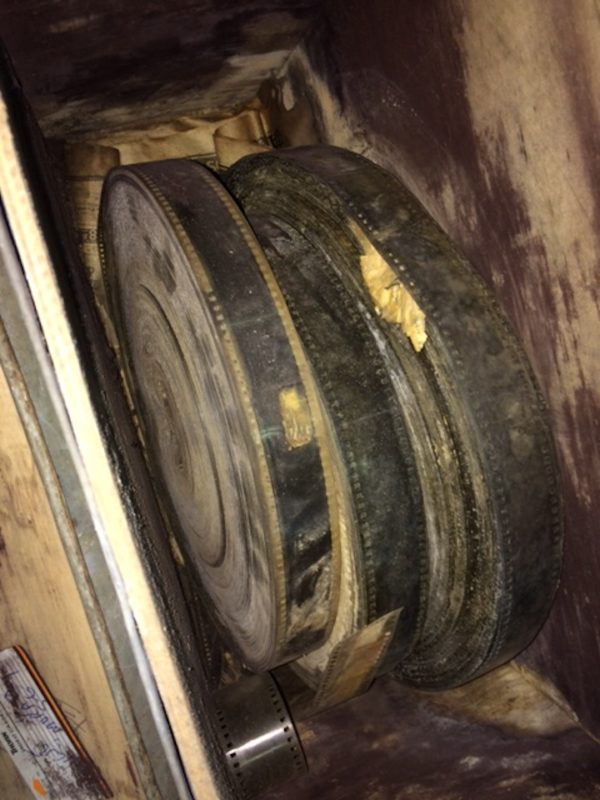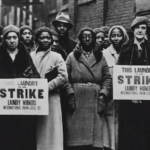Eastman’s South Asian Treasure Trove

Boxes of films as Eastman’s Deborah Stoiber found them. All images courtesy South Asian Cinema Collection at the George Eastman Museum.
Thanks to a substantial grant from the Institute of Museum and Library Services, the George Eastman Museum is hard at work – and will be for some time – restoring a large and unusual collection of films from South Asia.
In September, the Institute of Museum and Library Services, the primary source of federal support for United States libraries and museums, awarded the Eastman Museum $249,517 for its project.
The grant was made through the IMLS Museums for America grant program. It was one of 109 allocations to library and museum projects from a total injection of $19-million.
Eastman is using the grant, and other funds, to restore 1,285 Indian and Pakistani film prints. Archivists there believe their collection to be largest of its kind outside India.
At the end of 2014, the museum dramatically saved from destruction some 775 Indian film prints that had been abandoned at a closed multiplex cinema in California, the Indian American-owned Naz 8.
Since then, in 2016 the British Film Institute National Archive donated to Eastman 441 prints from South Asia, most of them Pakistani prints from 1939 to 1986 – potentially some rarities, Eastman archivists believe. Then in 2017, many more films came to Eastman from another failed cinema in Houston, Texas.
At a time when film-preservation work has been struggling to get going in India — from a low point — Eastman’s restoration project marks a major contribution to efforts to preserve South Asian film, long much neglected, before it’s too late.
Eastman’s South Asian film collection has films made in at least 11 languages, including Hindi, Urdu, Malayalam, Punjabi, Tamil, Telugu, Assamese, Bengali, and Gujarati — and they date from 1939 to 2013. They represent the output of several South Asian areas of film production, among them Bollywood, Lollywood, and the Malayalam, Punjabi, Tamil, and Telugu film centers.
Many are by acclaimed masters of cinema, such as Indian directors Sanjay Leela Bhansali, winner of five National Film Awards in India, who works in Hindi, and similarly decorated Mani Ratnam, who makes films in Tamil. Other Indian directors represented include such other luminaries as Anurag Kashyap; Nagesh Kukunoor, and Ashutosh Gowariker. Among pioneering Pakistani directors in the collection are Anwar Kamal Pasha and Sharif Nayyar. Over all, the films represent the vast range of interest in cinema on the subcontinent.
conserving, cataloging, sharing

Additional films came from the British Film Institute. Photo: Deborah Stoiber, Eastman
The George Eastman Museum’s plans include to conserve, catalog, and provide access to the films, but not to digitize them. That would entail complex copyright research and negotiations. Before even thinking about that giant step, Eastman must rehouse and clean many of the films to protect them from decay, mold, dirt, rust, and vinegar syndrome.
That work has been ongoing for a few years, now.
Caroline Yeager, associate curator in Eastman’s moving image department, says the museum has devoted many hours of staff time to preservation work on the collection, and now will be able to increase that significantly. The IMLS grant will enable Eastman to hire two more curators, for two years, dedicated solely to the project.
Eastman is preparing a catalog for eventual placement on its online collection database. To promote understanding of South Asian film and culture, the Museum will also lend out prints that are in fit state to be projected, as many are.
The Museum has held screenings of some films at its Dryden Theatre’s film programs, when that was possible, and will do so again when the threat of Covid-19 sufficiently diminishes.
Yeager adds that, thanks to the work of two students (who have since been hired by the National Film Archive of India), many film titles that came to the museum scrawled on film reels and cans, in several South Asian languages, have been decoded. As a result, the Museum has not had to require that its two new curators can handle that linguistic work.
As soon as the first part of the collection came to Eastman, its staff along with students at Eastman’s L. Jeffrey Selznick School of Film Preservation set to work, beginning with the basics. “There was basic work that had to happen immediately,” Yeager says. “That was a great way to introduce students to entry level archiving. They had to get in there. Films had to come out of boxes…”
With one staff member at a time, from a rotation of three or four, working with students, from 2014 to 2020 “student projects have chipped away at that,” she says.
The IMLS grant “will make a huge change,” she says. “Over the course of the grant, with the two new hires and a staff member rotating out there each week, we expect to be able to give all the films the cleaning and rehousing they need.” Then, the exhibition options will greatly increase.
a dramatic save
The Eastman Museum has long collected South Asian film, but its holdings swelled enormously, in one feel swoop, in late 2014. That was when a huge cache of Indian films turned up in an abandoned multiplex in California. They were there because, after shipment from India for release for specialized cinemas in the U.S., they were never returned.
That’s a common phenomenon: shipment costs a lot of money. But the special circumstance of the California multiplex was that it went broke when digital projection became almost universal in cinemas, during the decade after 2000.
When the multiplex closed in August 2013, release prints of 597 films in 35mm prints (with almost 200 duplicates), made between 1999 and 2013, were left in various storage spaces, along with several thousand movie posters.
An extraordinary reclamation project ensued, thanks to Dino Everett, the archivist of the Hugh M. Hefner Moving Image Archive at the University of Southern California’s School of Cinematic Arts. Upon discovering that the films and other material were about to be bulldozed along with the multiplex that housed them, he put out an urgent alert.
Then senior curator in the Eastman Museum’s Moving Image Department, Paolo Cherchi Usai, said that the material fit well within the institution’s longstanding interest in collecting South Asian film. So he instantly phoned the Louis B. Mayer Foundation — no time for grant applications, or even letters or email — and managed to secure funds to pack up the material and ship it to Eastman.
The shipping bill would run to $14,980.

Never how you want your film to look — many of the films are in good condition, but many not.
Eastman’s rapid response won the acclaim of archivists in the then-fledgling Indian film-restoration world. It was “to be applauded by all those who care for cinema as an art form,” said Shivendra Singh Dungarpur, founder and director of the Film Heritage Foundation in Mumbai. It was a “heroic feat” that would advance knowledge of Indian film, he said.
His thanks was unsurprising given that few efforts had been made within India, at that point, to collect or preserve the output of the vast Indian film industry that has for a century poured out films from multiple centers in the enormous and enormously populous country.
A striking feature of the Eastman collection, then, is its rarity, although huge numbers of South Asian films can be viewed on DVDs and through streaming.
The salvation of the films was a marvel of rapid action and mighty effort, as reporter Jeff Spevak detailed in a 2016 feature article. He related that in December 2014, when the Eastman Museum learned about what Dino Everett had stumbled upon, officials there swung into action. Eastman’s collection manager, Deborah Stoiber, flew to California, met Everett at the cineplex, and found he had rounded up 10 students from the University of Southern California as well as the University of California at Los Angeles. Even Stoiber’s parents joined in, having come down from Oregon to see her. (She dispatched her dad to a Home Depot to buy 10,000 feet of shrink wrap.)
Inside the Naz 8 cineplex, the last film screened was still on the projector. Behind the projection room, a room contained some 600 boxes of films, poorly labeled.
Also in the room were stacks of posters and boxes of soundtrack cassettes for distribution to patrons of screenings.
That room led to others, also full of films.
Everett’s student helpers were in the midst of final exams, and had only one day to devote to what would clearly take more. Stoiber persuaded the building’s owners to give her time to shift the haul. They offered only three extra days before locking the doors.
Stoiber hired a couple of movers, and ended up with two tractor-trailers filled with 1,300 boxes, including 597 films, 776 counting duplicates.
Back at Eastman, Cherchi Usai had been hard at work finding funds to get the film from the cineplex, across the country, to the museum.
The task, he later said, was undeniable: Eastman could not fail to save many years of Indian film heritage, “by far one of the most important film acquisitions in the history of the museum.”
The collection reflected, he said, the sheer gushing dynamism of Indian film production, from the popular to the esoteric. The scope and relentlessness of that production is a good part of what makes it so difficult to collect and preserve, he said: “It is such a deluge of creativity that there is no organized effort to preserve these films, no money to do so.”
Generally, as a result, prints become lost or destroyed.
The truckloads of films and related material pulled into Eastman, in Rochester, New York, on 31 December 2014, and cleaning and organizing the reels began.
The films from the Naz 8 in California, were in fairly good shape, canned and boxed, says Yeager. That was not the case with some of the later acquisitions. Some of those had been stored in rusted film cans and original shipping cases for 30 years or more, or in no cans, at all. Some had no cores, which tends to make reels of film collapse in on themselves. Many reels needed a lot of cleaning and other remediation after sitting in dusty storerooms for decades. That work will take years’ more work. “They have to be hand cleaned, given new leaders, and properly identified,” she says.
The many duplicates that the museum inherited have needed to be graded for quality and condition, so the best copies can be retained, the others de-accessioned or traded with other institutions.
{Click on an image to expand}
Stills and details from film posters in the Eastman collection. From top left: Om Shanti Om, Farah Khan, India 2007; Ghajini, 2008, by A. R. Murugadoss, India, Hindi & Urdu): A Hindi reworking of the director’s 2005 Tamil film; Dilwale Dulhania Le Jayenge, Aditya Chopra, India 1995; Devdas, Sanjay Leela Bhansali, India, 2002.
exhibition in the plans
But Yeager says she and her colleagues at Eastman now rest assured that the work will get done. The IMLS grant has taken care of that.
When again possible, Eastman will present more of the films in its film series.
And those activities increasingly will be complemented by efforts in India, such as at the National Film Archive in Pune, which is among institutions that are now seeking to repair the legacy of neglect of South Asian film output, over all.
That archive has been in operation for about 50 years, but “in truth,” says Yeager, “no one archive is ever going to be able to handle all the output of a national film industry. In India, it’s a huge challenge.”
Collaboration will be key. Just as difficult a task as Indian film preservation will be saving Pakistan’s film legacy. The country has no national film archive. That leaves collection and preservation up to distributors, producers, and collectors. “So we’re lucky to have these films,” Yeager says.
Looking at the films reels that have come in, and at the colorful posters that advertised them, she can say: “It’s all here. Everything that is in cinemas is here. Dramas, comedies, thrillers, chillers, cops & robbers… every genre is there.”
— Peter Monaghan
Previous Post: 47 Orphan Films To Be Preserved with Federal Grants








